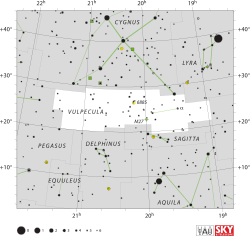26 Vulpeculae
26 Vulpeculae, som är stjärnans Flamsteed-beteckning, är en snäv dubbelstjärna[12] belägen i den mellersta delen av stjärnbilden Räven.[11] Den har en kombinerad skenbar magnitud på ca 6,40[2] och kräver åtminstone en handkikare för att kunna observeras. Baserat på parallax enligt Gaia Data Release 2 på ca 5,1[1] mas, beräknas den befinna sig på ett avstånd på ca 644 ljusår (ca 197 parsek) från solen. Den rör sig närmare solen med en heliocentrisk radialhastighet av ca -63 km/s[6] och förväntas kunna ligga på 225 ljusårs avstånd från solen om ca 2,6 miljoner år. [2]
| 26 Vulpeculae | |
 | |
| Observationsdata Epok: J2000.0 | |
|---|---|
| Stjärnbild | Räven |
| Rektascension | 20t 36m 08,3399s[1] |
| Deklination | +25° 52′ 57,5615″[1] |
| Skenbar magnitud () | +6,40 (V)[2], +6,406 ± 0,009[3] |
| Stjärntyp | |
| Spektraltyp | A5 III[4] |
| B–V | 0,158 ± 0,005[5] |
| Astrometri | |
| Radialhastighet () | -63,4 ± 2,3[6] km/s |
| Egenrörelse (µ) | RA: 26,010 ± 0,022[1] mas/år Dek.: 12,189 ± 0,022[1] mas/år |
| Parallax () | 5,0684 ± 0,0346[1] |
| Avstånd | 644 ± 4 lå (197 ± 1 pc) |
| Absolut magnitud () | -0,04[2] |
| Detaljer | |
| Radie | 4,6[7] R☉ |
| Luminositet | 79,75[8] L☉ |
| Temperatur | 7 888[8] K |
| Metallicitet | -0,06 (Fe/H)[2] dex |
| Vinkelhastighet | 15[9] km/s |
| Andra beteckningar | |
| HD 196362[10], SAO 88884[10], HIP 101641[10], HR 7874[10], 2MASS J20360833+2552574[10], GSC 02161-00007[10], BD+25 4299[10], GC 28679[10], GCRV 12887[10], HIC 101641[10], PPM 111474[10], ROT 7670[10], TD1 27001[10], TYC 2161-7-1[10], UBV 17877[10], uvby98 100196362[10], YZ 25 11515[10], SBC9 1247[10], SBC7 820[10], Gaia DR1 1855807986522402816[10], WEB 18361[10], Gaia DR2 1855807990831919360[10], 26 Vul, Gaia DR3 1855807990831919360[10], TIC 243441917[10], AG+25 2395[10], UBV M 24997[10] och Renson 54730[10][3][11] | |
Egenskaper redigera
Primärstjärnan 26 Vulpeculae A är en vit jättestjärna av spektralklass A5 III,[4] och misstänks vara en kemiskt ovanlig stjärna.[13] Den har en radie som är ca 4,6[7] solradier och utsänder ca 80[8] gånger mera energi än solen från dess fotosfär vid en effektiv temperatur på ca 7 900 K.[8]
26 Vulpeculae är en enkelsidig spektroskopisk dubbelstjärna med en omloppsperiod av 11 dygn och en excentricitet på 0,28.[12]
Referenser redigera
- Den här artikeln är helt eller delvis baserad på material från engelskspråkiga Wikipedia, 26 Vulpeculae, 20 september 2020.
Noter redigera
- ^ [a b c d e f] Brown, A. G. A.; et al. (Gaia collaboration) (August 2018). "Gaia Data Release 2: Summary of the contents and survey properties". Astronomy & Astrophysics. 616. A1. arXiv:1804.09365. Bibcode:2018A&A...616A...1G. doi:10.1051/0004-6361/201833051. Gaia DR2 record for this source at VizieR.
- ^ [a b c d e] Anderson, E.; Francis, Ch. (2012), "XHIP: An extended hipparcos compilation", Astronomy Letters, 38 (5): 331, arXiv:1108.4971, Bibcode:2012AstL...38..331A, doi:10.1134/S1063773712050015.
- ^ [a b] ”Basic data: V* 26 Vul – Spectroscopic binary” (på engelska). Centre de Données astronomiques de Strasbourg. http://simbad.u-strasbg.fr/simbad/sim-basic?Ident=26+Vul&submit=SIMBAD+search. Läst 7 juli 2019.
- ^ [a b] Cowley, A.; et al. (April 1969), "A study of the bright A stars. I. A catalogue of spectral classifications", Astronomical Journal, 74: 375–406, Bibcode:1969AJ.....74..375C, doi:10.1086/110819
- ^ van Leeuwen (2007). ”Hipparcos, the New Reduction” (på engelska). http://vizier.u-strasbg.fr/viz-bin/VizieR-5?-out.add=.&-source=I/311/hip2&HIP=101641. Läst 7 juli 2019.
- ^ [a b] Gontcharov, G. A. (2006), "Pulkovo Compilation of Radial Velocities for 35 495 Hipparcos stars in a common system", Astronomy Letters, 32 (11): 759–771, arXiv:1606.08053, Bibcode:2006AstL...32..759G, doi:10.1134/S1063773706110065.
- ^ [a b] Pasinetti Fracassini, L. E.; et al. (February 2001), "Catalogue of Apparent Diameters and Absolute Radii of Stars (CADARS)", Astronomy and Astrophysics (Third ed.), 367: 521–524, arXiv:astro-ph/0012289, Bibcode:2001A&A...367..521P, doi:10.1051/0004-6361:20000451.
- ^ [a b c d] McDonald, I.; et al. (2012), "Fundamental parameters and infrared excesses of Hipparcos stars", Monthly Notices of the Royal Astronomical Society, 427 (1): 343–357, arXiv:1208.2037, Bibcode:2012MNRAS.427..343M, doi:10.1111/j.1365-2966.2012.21873.x.
- ^ Royer, F.; et al. (October 2002), "Rotational velocities of A-type stars in the northern hemisphere. II. Measurement of v sin i", Astronomy and Astrophysics, 393 (3): 897–911, arXiv:astro-ph/0205255, Bibcode:2002A&A...393..897R, doi:10.1051/0004-6361:20020943.
- ^ [a b c d e f g h i j k l m n o p q r s t u v w x y z aa] SIMBAD Astronomical Database.[källa från Wikidata]
- ^ [a b] "26 Vul". SIMBAD. Centre de données astronomiques de Strasbourg. Hämtad 2019-03-17.
- ^ [a b] Pourbaix, D.; et al. (2004), "SB9: The Ninth Catalogue of Spectroscopic Binary Orbits", Astronomy & Astrophysics, 424: 727–732, arXiv:astro-ph/0406573, Bibcode:2004A&A...424..727P, doi:10.1051/0004-6361:20041213.
- ^ Renson, P.; Manfroid, J. (May 2009), "Catalogue of Ap, HgMn and Am stars", Astronomy and Astrophysics, 498 (3): 961–966, Bibcode:2009A&A...498..961R, doi:10.1051/0004-6361/200810788.



